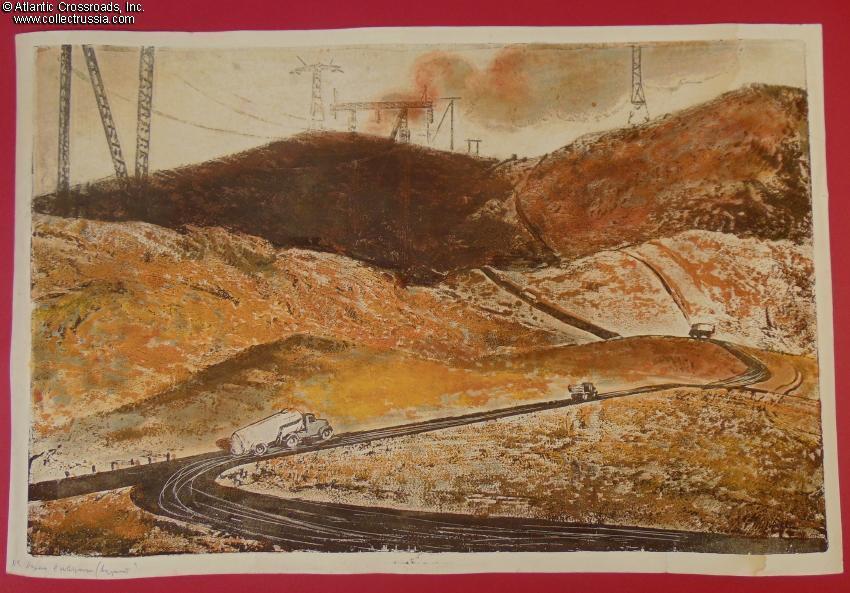
Road to Novotroitsk, a massive lithograph with gouache on paper depicting a Soviet landscape and roadway, by graphic artist Valentin Alekseevich Novichenko, circa 1980s-90s, 40 x 50 cm, good condition.
Despite the laconic and stern landscape that pictures roads, high power lines and trucks, the painting is dominated by warm ochre tones. The mountains of ochre color remind that brown iron ores have been found here, the unique source of nickel, titanium and other scarce metals, as well as the ochre pigment from which the paints are made. The famous geologist Fersman called these lands the "True Pearl of the Urals."
This landscape is a continuation of the industrial theme. On one side, everything is subordinated to one goal: the road is leading to Novotroitsk
Despite the laconic and stern landscape that pictures roads, high power lines and trucks, the painting is dominated by warm ochre tones. The mountains of ochre color remind that brown iron ores have been found here, the unique source of nickel, titanium and other scarce metals, as well as the ochre pigment from which the paints are made. The famous geologist Fersman called these lands the "True Pearl of the Urals."
This landscape is a continuation of the industrial theme. On one side, everything is subordinated to one goal: the road is leading to Novotroitsk, the location of one of the largest groups of metallurgical enterprises in the country. The city was built specifically for its workers, and it was there that the future artist Novichenko was born into a family of a metallurgical worker. Thus from the other point of view, for Novichenko this is the road home, back to his childhood. The warm colors afford lyricism to the stern landscape.
The texture of the gouache, on top of the color, imbues the scene with additional life. The viewer feels much closer to the rolling hills than to the distant and relatively flat power lines. By crafting the landscape in layers - the hills rendered with the thickest paint - there a sense of depth and monumentality. The paintings is in overall good condition. There are some minor signs of wear, including slight discoloration of the paper around the white border (particularly at the top and bottom right of the piece). The paper itself is mildly worn with a small nick in the middle of the larger cloud on the right. The work has otherwise kept up well, and if anything, these slight imperfections add further character to the industrial scene. The artist has written the name of the painting, "Road to Novotroitsk", at the bottom left corner.
Valentin Alekseevich Novichenko (1927-2010) is a well-known graphic artist from the Urals. He was born into a working- class family. His childhood impressions of industry and the construction of the Orsk Metallurgical Kombinat (group of factories) deeply affected his art.
He participated in the Patriotic War and then graduated from the Sverdlovsk Art School, which he attended from 1956-61. In 1966 he became a member of the Trade Union of Artists of the USSR and a permanent member of all-Union exhibitions. From 1953-63 he worked as a decorator at the Uralkhimmash and Uralmash, both of which were gigantic powerhouses of Soviet industry that played an extremely important role in the development of the industrial might of the Soviet Union as well as its defense during the Great Patriotic War. They also played major role in the development of the city of Yekaterinburg (then Sverdlovsk) and the entire Ural Region.
Thanks to Novichenko's art, labor at the factory was aestheticized and glorified. It appeared then that people will always get up early in the morning, and by the factory siren, head to work their shift. They believed that they lead a decent life - a life worthy of being the subject of art, i.e. being reflected in paintings and cinematography.
The lithographs by the artist are a memory of the departing character of an entire civilization. The representation of labor in the art of Socialist Realism and the themes of "labor", "production" and "the worker" had become leading and dominant over all other subjects and themes. In the art of the 1930s-50s, the portraits of people dominate, whereas the sources of power - such as hydroelectric dams, blast furnaces, electric power lines - serve only as a background for their laborial heroism. Artist Novichenko turned it upside down: his inanimate objects are far more interesting than the people and whatever they are doing. He was one of the first to create a tendency that would be well established in the industrial Socialist Art of 1970s-80s: the hero and background change places. The people are simply serving the giant objects; they are just a part of the industrial process. This was due to the fact that the portrait of the original hero of Socialist Realism was getting ideologically worn out. Novichenko is presenting a new industrial still nature: giant cones, cylinders, and gears are distributed on a plain as if in paintings by Cézanne, where the household items and fruits attract attention primarily by the play of their forms.
After the death of the artist in 2010, a number of his
exhibitions have opened in his native Ural and Moscow, and
well known collectors are now trying to acquire his works.
As clearly evident from his correspondences with colleagues
that is now kept in a private collection, Novichenko had a
difficult personality. He never tried to sell his works to
collectors or earn good favors from the bureaucrats
managing
arts; he also refused to sell his painting to the managing
committees of exhibitions on their terms. He was a tireless
innovator, always in search of new materials and
techniques,
and this consumed his entire life. His lithographs on metal
or so-called "poly etching graphics" that employed various
techniques and metal cutting instruments invented by him,
and his unusually large lithographs, make his art truly
unique and of enduring value.
$175.00 Add to cart








